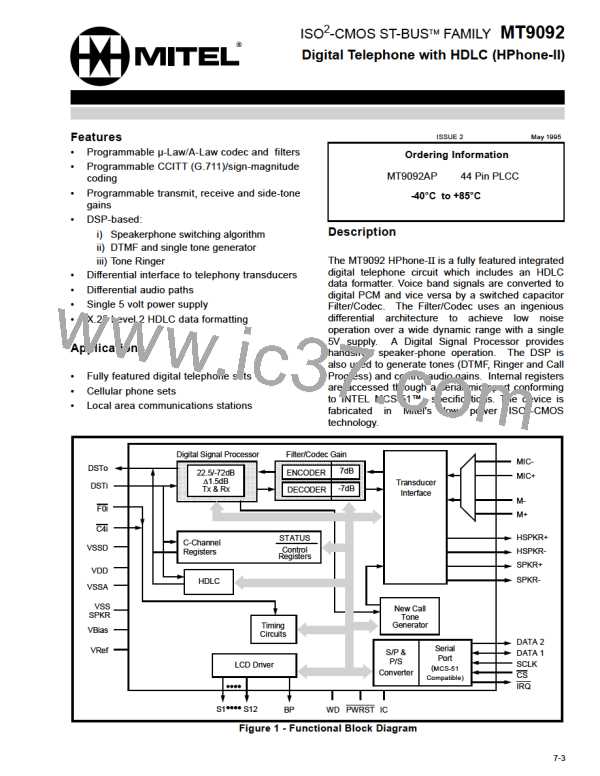MT9092
All selected interrupt events will cause the IRQ pin to
become active. Unselected interrupt events will not
cause IRQ to become active however, the event will
still be represented by the appropriate bit in the
HDLC Interrupt Status Register (address 07h). This
register must be read after receiving an IRQ or may
be polled at any time. The IRQ output pin is reset
coincident with the first SCLK falling edge following a
Command/Address byte which indicates a microport
read of address 07h. Since all interrupts are
generated by the occurrence of an HDLC event (i.e.,
a transition), this register informs that an event has
occurred but does not guarantee that it is still valid.
To determine current validity the HDLC Status
Register (address 04h) should be read. Due to the
asynchronous nature of the interrupts an interrupt
occurring during a read of the Interrupt Status
register will be held until the read cycle is over,
unless it is an interrupt which is already valid.
becomes completely full; a condition
which may result in a receive overflow
condition. By setting the Flrx bit
(address 05h) high the FIFO filling
condition will occur when a transition
from 4 to 5 bytes occurs. This will
allow the microport more time to react
to this interrupt condition.
RxOvfl - Receive FIFO Overflow:
Set when the receiver attempts to
write data into an already full Rx FIFO.
Under this condition the HDLC will
disable the receiver until a new flag is
detected. See also Receive FIFO
Status.
Disabling, Reset and Transparent Operation
Disabling of the receiver via the HRxEn bit will occur
after the current packet is completely loaded into the
Rx FIFO. Disabling can occur during packet
reception if no bytes have been written to the Rx
FIFO yet. The Rx FIFO, status and Interrupt registers
may still be read and control registers written while
the receiver is disabled. Note that the receiver
requires the reception of a flag before processing a
packet, thus if the receiver is enabled in the middle
of an incoming packet it will ignore that packet and
wait for the next complete one.
There are six interrupts associated with the receiver.
GA
Go Ahead:
Set when
a
go-ahead pattern
(011111110) has been detected by the
receiver.
EOPD
End Of Packet Detect:
Set when an end of packet byte has
been written into the Rx FIFO by the
receiver. This event may be due to
receiving a closing flag, an abort
sequence or an invalid packet.
The Rx FIFO may be reset by setting the Rxfrst bit in
the HDLC Control Register 2 (address 05h). The
receiver will be disabled until reception of the next
flag. The Status Register will identify the Rx FIFO as
being empty although the actual data in the FIFO will
not be reset. Rxfrst will be cleared by the reception
of the next received flag pattern.
EopR
End of packet Read:
Set when the next byte to be read from
the Rx FIFO is the last byte of a
packet or when a read to an empty Rx
FIFO has occurred.
Data may be received transparently by setting the
TRANS bit (address 03h) high. Timing control bit
FA
Frame Abort:
CH EN must also be set. The receiver will disable
Set when a frame abort sequence is
received during packet reception. The
0
protocol functions such as flag/abort/go-ahead/idle
detection, zero deletion, CRC calculation and
address comparison. Data is shifted into the Rx FIFO
in a byte-wide format. In transparent mode when an
Rx FIFO overflow condition occurs the receiver will
continue to write data into the Rx FIFO, overwriting
the last byte. The overflow interrupt condition can
only be detected again if the Rx FIFO is reset (Rxfrst
bit at address 05h) since normally the overflow
condition is cleared by the reception of the next flag
and transparent data is unlikely to emulate a flag.
Also, the Rxfrst bit itself will have to be reset by
writing it low since it is usually reset automatically by
the occurrence of the next flag.
aborted packet must contain
a
minimum of 26 bits for the FA
sequence to be recognized. Note that
this register bit position is shared with
the transmitter under-run (Txunder)
interrupt (see transmit interrupts). For
this bit to reflect FA the Intsel bit in
Control Register 2 (address 05h) must
be set low.
RxFf - Receive FIFO filling:
Set when a transition from 14 to 15
bytes in the Rx FIFO has occurred.
This is an early warning to the
microprocessor that the FIFO is filling
and should be serviced before it
7-16

 MITEL [ MITEL NETWORKS CORPORATION ]
MITEL [ MITEL NETWORKS CORPORATION ]